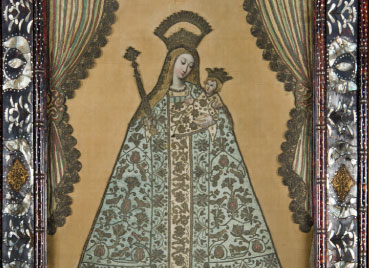The Bordadita

The Bordadita is the patron saint of the Colegio Mayor, to whom the chapel located on the south-east side of the Cloister is dedicated.
The image is made of textile and pictorial elements. It is associated with the legend that it was embroidered by the Queen of Spain, whom Friar Cristobal made a devotee of the Rosary.
Listen to the hymn of The Bordadita
Presentation
Erected as the heart of the Cloister of Our Lady of the Rosary, the Bordadita chapel was built in the 17th century. Its facade, cemented in stone, presents an entrance arch that opens on a smooth veneered wall, framed by columns with Corinthian capitals; the pediment, finished in 1654, is round and has five figures in clay and stucco. The Archivolta, with the Ave Maria in Latin, dates from 1883, while the original door features Renaissance spiked in bronze and a 17th century lock.
The central nave has a vault and flat roof, while its walls, built in masonry, are about two meters thick. While the current altar, designed by the architect Germán Téllez in 1971, is a monolith built for the celebration of the liturgy in front of the people; It also shows as a unique decoration the rosary shield of Calatrava, according to drawing by maestro Luis Acevedo. The altarpiece has been modified on several occasions, currently the design of the master Luis Acuña, who inspired by the colonial baroque projected two bodies, a pedestal and three streets. It is crowned by the shield supported by angels and in the upper body it presents an old Quito from the 18th century that makes a harmonious joint with the paintings of the Dolorosa and the Apostle San Juan, works of Acuña. In the center is the image of the Bordadita in a Florentine frame, under the archbishop's shield of Fray Cristóbal de Torres and in the niches of the side streets you can see the images of Santo Tomás and San Buenaventura. The Tabernacle is embedded in the central street.
The chapel choir retains its original structure, and the sacristy, built in 1785 by Rector Alarcón and Castro, was again renovated in 1972. Currently, both the Cloister and the Chapel are buildings of great heritage value.
The Altarpiece
La Bordadita has changed several times from Altarpiece. One is remembered that Masústegui ordered to work but disappeared in the civil wars and another neoclassical in wood imitating marble, which Monsignor Carrasquilla had built and was replaced by the current one.
This altarpiece was designed by the master Acuña inspired by the colonial baroque and consists of two bodies, a pedestal and three streets. It is crowned by the shield supported by angels and in the upper body it features an old Quito church from the 18th century that makes a harmonious ensemble with the paintings of the Dolorosa and the Apostle San Juan, works of Acuña.
In the center is the image of La Bordadita in a beautiful Marco Florentino, which was described thus by Ibáñez: “... standing on a pedestal where angels faces stand out, the body has the pyramidal figure adopted by the painters of the Middle Ages and is covered by a dress and a cape adorned with neat ornaments.
He covers his head a crown of exaggerated size for the dimensions of the figure, holds in his left arm the Child, also crowned, and in the right hand a scepter and a rosary.
The queen embroidered on the yellow background of the painting ... ”(Chronicles. Volume I Pag. 199, Bogotá, 1951). The image of the Patroness also shows the Boyacá Cross conferred by the National Government in 1953.
Under the picture is the archbishop's shield of Fray Cristóbal de Torres and in the niches of the side streets you can see the images of Santo Tomás and San Buenaventura. The Tabernacle is embedded in the central street.
This new altar, designed by the architect Germán Téllez, is a sober stone monolith, built in 1971 for the celebration of the liturgy in front of the people. It shows as a unique decoration the rosarista shield of Calatrava, according to drawing by maestro Luis Acevedo.
It was rebuilt in 1785 by Rector Alarcón and Castro after an earthquake and was renewed again in 1972.
"The facade of the chapel, which faces the 6th race, has an entrance arch framed by columns with capitals of the Corinthian order. Concluded in 1654, the tympanum of the pediment has five bulge figures: in the center is the Virgen del Rosario with El Niño, next to Santo Domingo and Santa Catalina de Siena, occupying the celestial plane, and on the earthly are Santo Tomás de Aquino and Fray Cristóbal de Torres, on their knees.They were made in baked clay and stucco by the Santa Sculptor Antonio de Pimentel in the 17th century ”(Londoño Vélez, 2013: 162).
It retains its original structure, since since the renovation it was again the same as in its foundation.
It has a flat vault and tester and its colossal walls built in masonry are about two meters thick. The current craft is the work of the teacher Acuña in 1953.
